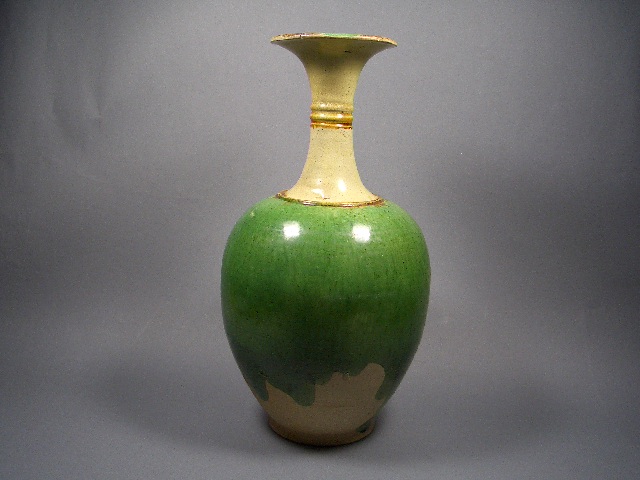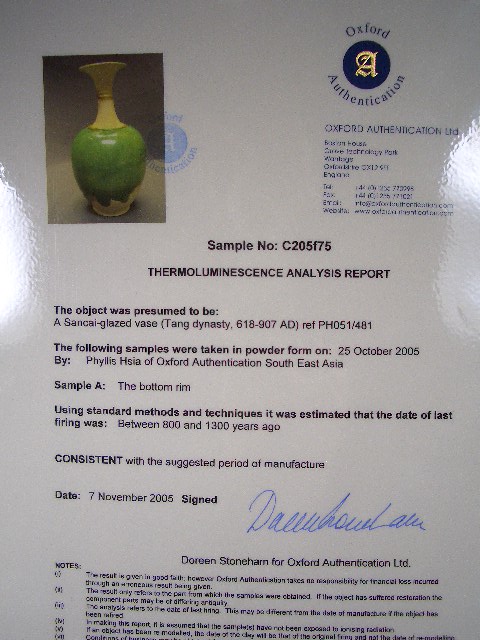2024.3.16
Gallerist's small episodes vol.7 | Is the Sansai Jyobot authentic? fake?

sancai vase
【IZUMI Suzuki Owener of Izumi】
Recently, I have come across many counterfeits of ancient Chinese ceramics in advertisements in antique magazines, on Internet homepages, and at auctions.
You could say it's a counterfeit paradise. It may seem cute to sell Tang Sancai vases or horse lanterns for 10,000 to 20,000 yen, but there are some unscrupulous dealers who use clever tricks to sell well-made counterfeits to beginners and amateurs.
So, is there a way for amateurs to avoid falling prey to forgeries? There's only one thing. Don't buy that. It may sound like a joke, but I think it's safest to buy from a reliable and discerning vendor. (However, please be aware that there are many self-proclaimed connoisseurs in this world.) Top-notch contractors not only have a wealth of experience, but also make great efforts to hone their aesthetic sense every day. Additionally, we value trust above all else, so we will never knowingly sell counterfeit products to our customers.
However, even the most connoisseur can make mistakes from time to time, so I would rather not be an amateur.
By the way, the Sansai jobot shown in the photo was exhibited at a trader's exchange meeting, and opinions among the members were divided over its authenticity. The people who say it's bad say, ``It's a counterfeit of the Tang Sancai from the High Tang Dynasty.This green glaze color doesn't exist in the High Tang Dynasty.And the shape is very Japanese-style.''Those who say it's good say, ``This is a counterfeit piece aimed at the Tang Sancai from the High Tang Dynasty.'' ``It's not from the High Tang Dynasty, but from the Late Tang Dynasty to the Fifth Dynasty, and while there are many inferior products, it's rare to find one of this quality.''
Actually, I bought this item in Hong Kong 15 years ago for 2 million yen, and a top-notch dealer in Tokyo bought it for 2 million yen at an exchange event. When it was passed around and returned to me, many dealers thought it was a fake, and the winning bid was a whopping 150,000 yen. I thought it was a masterpiece from the Five Dynasties of the Late Tang Dynasty, but I couldn't sell something that wasn't clear to customers, so I brought it to Hong Kong to rely on scientific dating methods. Do you know about thermoluminescence method? To put it simply, radiation is constantly emitted into the atmosphere, and as soon as ceramics are fired, they start absorbing radiation. The amount of radiation absorbed and accumulated is proportional to the age of the ceramic after firing, so it is a method to determine the firing age by collecting powder from the ceramic and applying it to a measuring device to measure how much radiation the ceramic has accumulated. . In addition, when heat is applied to the ceramic again, the radiation that has been accumulated up to now disappears and is reset to zero, and the absorption of radiation begins again.
Although this thermoluminescence method has recently become more accurate due to the efforts of researchers, it is still not 100% accurate.
Due to the application of heat to excavated items for cleaning or repair, measured values may be far from the actual age.
In order to get the measurements as close to accurate as possible, it is necessary to identify the place of origin. This is because the amount of radiation emitted varies depending on location.
Ceramics from the Han and Tang dynasties have a discrepancy of about 200 years. In addition, holes must be drilled into some of the ceramic pieces to collect the powder, which may significantly damage the antiquity value of some items. The test fee will be 3,500 Hong Kong dollars (approximately 55,000 yen in Japanese yen).
It was started by the University of Hong Kong for the general public about 20 years ago, but it seems to be popular now. In Europe and America, there are many buyers who request that old ceramics, excluding Qing Dynasty porcelain, be authenticated using this thermoluminescence method, and they are sometimes a little taken aback when this test is performed even on items that are obviously genuine.
Tests of the Sansai Jobot have shown that they are between 800 and 1300 years old. I was relieved that it was determined to be the real thing, but at the same time I was excited to see how much it would sell for. 
This article was published in the February 2006 issue of the ancient art and antique information magazine "Small Buds". Today, 18 years later, this item is believed to be Sancai from the early Tang Dynasty, not the late Tang Dynasty. It made me realize that as an antique art dealer, I need to continue researching and making efforts without being satisfied with my own visual ability.
【IZUMI Suzuki / Owner of Izumi】
---------------------------------------------------------------------------------
古美術いづみ GALLERY IZUMI
12時~18時
東京都中央区京橋2-6-8 孤松庵ビル1階
Koshoan bldg. 1F. 2-6-8 Kyobashi, Chuo-ku, Tokyo
TEL:03-3567-1034
WEB:https://www.kobijutsuizumi.com/
---------------------------------------------------------------------------------
"Gallerist's small episodes'' features contributions from unique shopkeepers who set up shops in this artistic town. If you have any interest in art, the town, or anything else, please come visit the owner's shop and listen to what he has to say.
translated by Google translation
